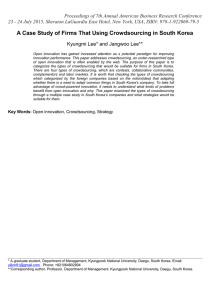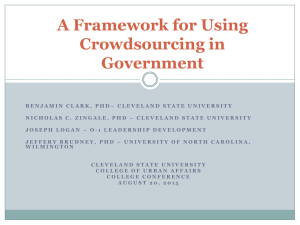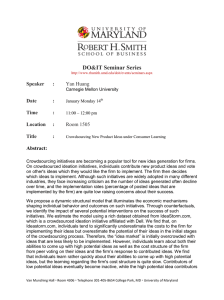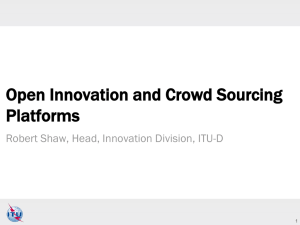A Cross-Cultural Study of Motivations to Participate
advertisement
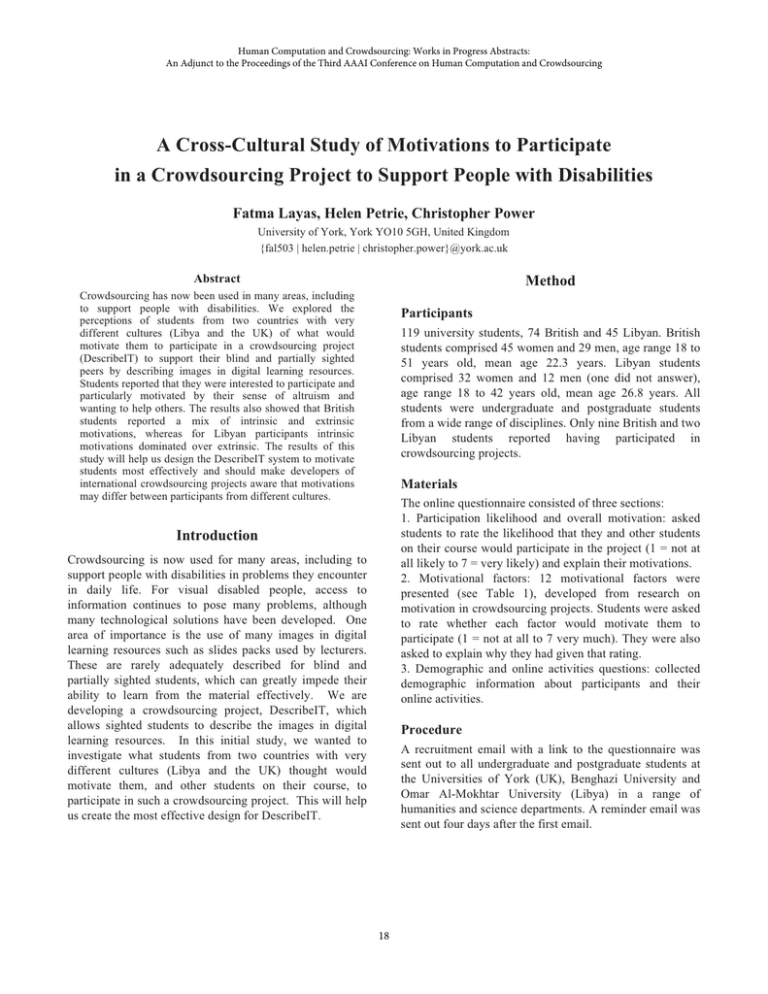
Human Computation and Crowdsourcing: Works in Progress Abstracts:
An Adjunct to the Proceedings of the Third AAAI Conference on Human Computation and Crowdsourcing
A Cross-Cultural Study of Motivations to Participate
in a Crowdsourcing Project to Support People with Disabilities
Fatma Layas, Helen Petrie, Christopher Power
University of York, York YO10 5GH, United Kingdom
{fal503 | helen.petrie | christopher.power}@york.ac.uk
Abstract
Method
Crowdsourcing has now been used in many areas, including
to support people with disabilities. We explored the
perceptions of students from two countries with very
different cultures (Libya and the UK) of what would
motivate them to participate in a crowdsourcing project
(DescribeIT) to support their blind and partially sighted
peers by describing images in digital learning resources.
Students reported that they were interested to participate and
particularly motivated by their sense of altruism and
wanting to help others. The results also showed that British
students reported a mix of intrinsic and extrinsic
motivations, whereas for Libyan participants intrinsic
motivations dominated over extrinsic. The results of this
study will help us design the DescribeIT system to motivate
students most effectively and should make developers of
international crowdsourcing projects aware that motivations
may differ between participants from different cultures.
Participants
119 university students, 74 British and 45 Libyan. British
students comprised 45 women and 29 men, age range 18 to
51 years old, mean age 22.3 years. Libyan students
comprised 32 women and 12 men (one did not answer),
age range 18 to 42 years old, mean age 26.8 years. All
students were undergraduate and postgraduate students
from a wide range of disciplines. Only nine British and two
Libyan students reported having participated in
crowdsourcing projects.
Materials
The online questionnaire consisted of three sections:
1. Participation likelihood and overall motivation: asked
students to rate the likelihood that they and other students
on their course would participate in the project (1 = not at
all likely to 7 = very likely) and explain their motivations.
2. Motivational factors: 12 motivational factors were
presented (see Table 1), developed from research on
motivation in crowdsourcing projects. Students were asked
to rate whether each factor would motivate them to
participate (1 = not at all to 7 very much). They were also
asked to explain why they had given that rating.
3. Demographic and online activities questions: collected
demographic information about participants and their
online activities.
Introduction
Crowdsourcing is now used for many areas, including to
support people with disabilities in problems they encounter
in daily life. For visual disabled people, access to
information continues to pose many problems, although
many technological solutions have been developed. One
area of importance is the use of many images in digital
learning resources such as slides packs used by lecturers.
These are rarely adequately described for blind and
partially sighted students, which can greatly impede their
ability to learn from the material effectively. We are
developing a crowdsourcing project, DescribeIT, which
allows sighted students to describe the images in digital
learning resources. In this initial study, we wanted to
investigate what students from two countries with very
different cultures (Libya and the UK) thought would
motivate them, and other students on their course, to
participate in such a crowdsourcing project. This will help
us create the most effective design for DescribeIT.
Procedure
A recruitment email with a link to the questionnaire was
sent out to all undergraduate and postgraduate students at
the Universities of York (UK), Benghazi University and
Omar Al-Mokhtar University (Libya) in a range of
humanities and science departments. A reminder email was
sent out four days after the first email.
18
Results
Discussion and Conclusions
Overall, students gave a mean likelihood rating that they
would participate of 4.9 (SD = 1.8), significantly above the
midpoint of the scale (t = 5.45, df = 118, p < 0.001). They
gave a mean rating of 4.1 (SD = 1.55) to the likelihood of
other students on their course participating, not
significantly different from the neutral midpoint of the
scale (t = 0.41, df = 118, n.s.). A two way analysis of
variance showed that there was a significant difference
between students’ ratings of their own likelihood of
participating and other students’ likelihood of participating
(F = 25.80, df = 1, 117, p < .001), with students in both
countries giving higher ratings for themselves in
comparison to other students. There was also a significant
difference between the two countries (F = 4.39, df = 1,
117, p < 0.05) with students in Libya giving significantly
higher ratings than students in the UK.
Students’ ratings of what extent each of 12 factors
would motivate them to participate are summarized in
Table 1. One-sample t-tests tested whether the ratings of
the 12 motivational factors differed significantly from the
neutral midpoint of the rating scale (indicated with a + or –
in Table 1) and showed a number of significant
differences. A two way analysis of variance showed that
there were significant differences between the ratings of
the 12 motivating factors (F = 26.59, df = 11, 1287, p
<.001), but there was no overall significant difference
between ratings by British and Libyan students (F = 2.86,
df = 1, 117, n.s.). However, there was a significant
interaction between motivating factors and country (F =
8.63, df = 11, 1287, p < .001), meaning that the pattern of
ratings was different between the different countries
(significant differences between the countries are indicated
in Table 1 with *).
This study of British and Libyan students’ perceptions of
their own and other students’ motivations to participate in a
crowdsourcing project to help visually disabled students
has yielded interesting results. Overall the students rated
their likelihood of participating as positive (significantly
above the midpoint of the scale), although they thought the
likelihood of other students was only neutral. In addition,
Libyan students gave significantly higher ratings of both
their own and other students likelihood of participating in
comparison to UK students, showing an overall cultural
difference.
When presented with 12 typical motivational factors,
students rated these significantly differently, with altruism
being the only positive factor on which Libyan and UK
students agreed. Other positive motivators for the Libyan
students were the fun and entertainment of the activity and
knowing they were contributing to a large project, whereas
for UK students they were being paid and enhancing job
opportunities. The results also showed that British students
reported a mix of intrinsic and extrinsic motivators,
whereas for Libyan students intrinsic motivators dominated
over extrinsic motivators.
The results of this study will help us design the
DescribeIT system to motivate students most effectively to
participate in the process of describing images for their
blind and partially sighted peers. Crowdsourcing projects
are often international, so developers need to be aware that
what motivates different cultural groups may well vary.
Finally this study has asked students what would motivate
them, in evaluating the implemented system, we will
investigate how students’ self-reports compares with their
actual behavior.
Mean Rating (SD) Mean Rating (SD) Mean Rating (SD)
UK
Libya
All
5.42 (1.51) +
5.91(1.87) +
5.61 (1.66)
Your sense of altruism, wanting to help other students (IN)
Improving your academic skills (EX)
4.15 (2.14)
5.00 (2.26) +
4.47 (2.21)
Being paid for your efforts (EX)
5.04 (2.02) + *
2.84 (2.39) - *
4.21 (2.41)
Enhancing your job opportunities in the future (EX)
4.53 (2.05) +
4.69 (2.47)
4.59 (2.21)
Being connected with other students on course (IN/EX)
3.57 (2.07)
4.53 (2.29)
3.93 (2.20)
The fun and entertainment of the activity (IN)
4.11 (1.93)
4.82 (2.38) +
4.38 (2.13)
To pass the time (IN)
2.88 (1.78) 2.60 (2.19) 2.77 (1.94)
Knowing that you are contributing to a large project (IN)
4.36 (1.65)
5.13 (2.28) +
4.66 (1.94)
The social recognition you would receive (EX)
2.54 (1.71) 3.44 (2.50)
2.88 (2.08)
Drawing attention to your skills (EX)
2.97 (1.87) 3.69 (2.37)
3.24 (2.09)
Being in a competition with other students (EX)
2.18 (1.67) - *
3.91 (2.40) *
2.83 (2.14)
Getting academic credits (EX)
4.28 (2.11)
3.96 (2.51)
4.16 (2.27)
Motivational factor
Table 1: The 12 motivational factors (EX = external motivator, IN = Internal motivator; + = significantly above the midpoint of the
rating scale; - = significantly below the midpoint; * = UK and Libya significantly different in rating)
19


